How to provide 100% remote integration services?
When health regulations limit on-site travel, should we stop implementing our control platforms? Or should we reconfigure our services to provide them entirely remotely? Covid-19 has prompted us to rethink the way we support our customers in remote mode. Here's a look back at some novel services - when technology teleports the expertise of our consultants! A new way of supporting our customers, 100% remote and 100% adopted!
From project launch to training, services reconfigured in "remote" mode
When a company chooses the VIRAGE piloting offer, it's the choice:
- control software - Project Monitor or Perf Monitor
- implementation and integration services
- support over time with the resources of customer excellence
Project launch and scoping, requirements gathering workshop, steering committee, user training: Before COVID-19, these collective workshops were conducted face-to-face. When it's no longer possible to travel, when project teams are all telecommuting: we have to rethink our remote interventions. An Internet connection, a webmeeting platform, and the implementation takes place in "remote" mode!
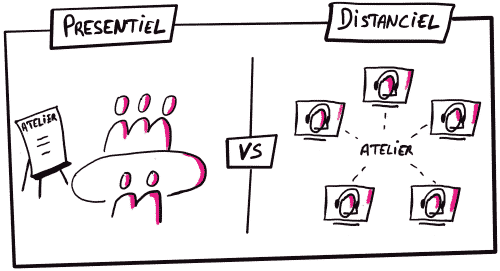
Remote requirements gathering workshops.
We can no longer come on site, but we can come "virtually". Our consultants teleport themselves thanks to technology. Group workshops have been redesigned in webconference mode. Sessions are held in 2-hour blocks, using a meeting platform such as Teams, Zoom or Gotomeeting, depending on the customer's tools and authorizations. The workshops are facilitated using our "mind map" tools for gathering and analyzing requirements. All the key points are swept up in an open manner, resulting in an exhaustive "needs map".
"The key points of a virtual workshop are good audio quality, animation of the session with a mindmap - screen sharing - and when the network allows it, the webcam" - Tony Bocock Expert Consultant
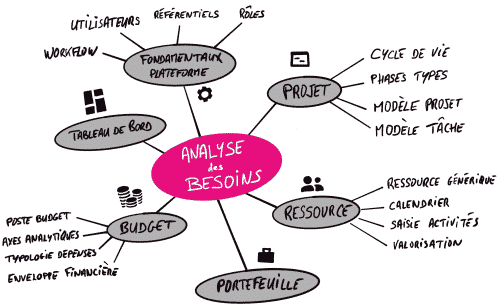
example of a mind map in sketchnote format
Workshops are conducted using mindmapping software such as xmind or mindjet.
Installation of the control platform - remote with enhanced security
Depending on the option chosen - Software as a Service or On Premise - the technical implementation of the control platform is carried out either :
- activation of a private cloud environment for Virage
- installation of the platform within the customer's IS and technical configuration of the servers
In most cases, these operations were already performed in remote session mode. The special feature of COVID-19 is that it enables security protocols to be applied from personal connections. New protocols and enhanced security have made it possible to continue these technical operations remotely.
"The ability to securely access customer platforms, whether SaaS or On premise, enables us to work efficiently even remotely" - Tony Bocock Expert Consultant
Skills transfer and parameterization via split-screen
Once the needs analysis sessions have been completed, future Functional Administrators are trained to :
- learn how the software works
- project themselves into their future roles as directors
- monitor the settings made by our consultants
The sequencing of director training has been reviewed. Instead of a full day of skills transfer, training sessions have been broken down into half-days. This format is best suited to distance learning. It's difficult to envisage a full day of training via screen. This also enabled us to put the system through its paces for user training.
As far as functional configuration was concerned, our consultants were already carrying this out largely remotely. There's nothing new in this phase, apart from the reinforcement of security. The involvement of future administrators in this key phase, to understand the reasoning behind the choice of one of several possible settings, is done through "screen sharing". And the key stage of the configuration review is carried out by web-conference, inviting the project sponsors as well as the administrators.
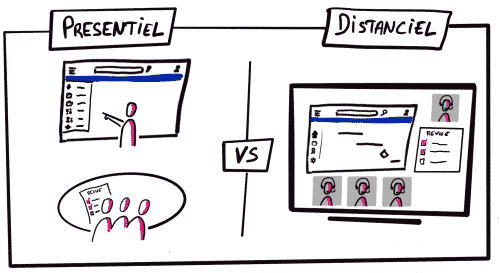
User training - classroom virtualization!
This was the phase where we had the most questions. Is it possible to run a user training course without being physically present? We didn't want to switch to an e-learning self-training system. Direct interaction with the trainer is essential for us. Our software is simple and intuitive, and our training sessions are not focused on "How does it work?" but on "How will you be able to use it in your business?"
Training for administrators validated the pedagogical relevance of half-day sessions. We applied the same principle to user training. Work in 1/2-day sessions. In terms of facilitation, exercise time was reinforced. To ensure that the trainees had fully grasped the concept, the trainer handed over his or her role as facilitator to a user who, by sharing a screen, explained the notion being worked on. A very effective reformulation / validation of acquired knowledge.
"Being remote means that the different stages of training can be better segmented into half-days. It leaves users more time to manage their work in the appendix." Cyril Plassa
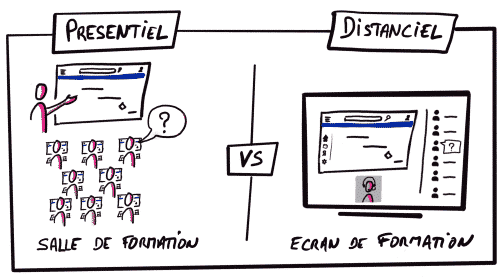
"Tele" project management for setting up the project platform
Setting up a project management platform is also managed in project mode! Managing this type of project is :
- structured and sequenced by a schedule project - monitored on our own platform Project Monitor
- animated by project points - carried out weekly with reports in the form of action plans (drafted and shared via Project Monitor)
- punctuated by steering committees for key stages - launch, validation of parameterization and transition to production/run
The committees were run in webmeeting mode, with presentation materials being shared. To increase the efficiency of these sessions, steering committee materials are prepared jointly by the customer project manager and the Virage project manager, and the arbitration process is anticipated.
Paradoxically, project planning has been made easier. On-site interventions involve logistical constraints, particularly in terms of transport, which impose full working days. Working remotely means working in shorter sequences. It is therefore much easier to find common work slots. Bottom line: implementation times have been shortened!
"We saved more than two weeks on the opening of production compared with the initial schedule for the Nantes University Hospital project. This time saving was achieved during the requirements gathering and configuration phases" - Cyril Plassa Project Manager
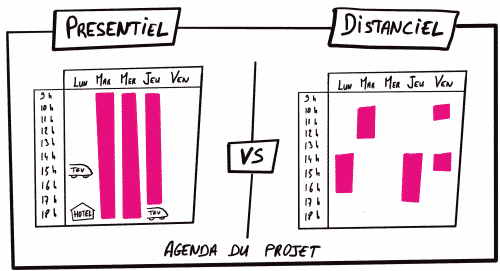
Remote services a success
For health reasons, we opted for the full remote mode. Although this mode of intervention was already integrated into our practices, its generalization to all phases of the project proved positive. Whether in terms of pedagogical devices or simplified planning, we and our customers have been delighted with the way the project has gone.
"Of course, we miss the conviviality of working together with our customers. But we're finding that, in practical terms, implementation, parameterization and training all go very well remotely. The only downside is that it's easier to build links with project teams during lunch breaks and informal discussions over a cup of coffee" - Tony Bocock - Expert Consultant
🔎 Our tips for working remotely :
- Multiple webmeeting platforms - not all of them work according to IT and security regulations
- Choose headphones with microphones for the best possible sound
- Prepare a support to share to animate your sessions - Our mindmaps have proven to be extremely effective!
- Work in sequences of no more than 2 hours
- Record the meeting (via Zoom for example): this allows you to recall the highlights and complete the minutes!
- Limit group sessions to 5 participants.
- Limit remote training to 6 users to guarantee interactivity
The final word:
The feeling: A 100% remote implementation as effective (if not more so) than face-to-face! - Cyril Plassa Project Manager